Digital LED screens and American bureaucracy
Recently, in the middle of the 90s nobody even thought about networks of digital LED screens because there was no such term. Separately standing lamp screens had already appeared but they were cumbersome, with low resolution and extremely uneconomical in energy consumption. Then, in 1996 a team of Russian engineers registered a series of patents on Outdoor TV and Network principle of digital LED screen organization.
The patents were made public purposely to let idea spread faster and without hindrance. For that moment Russian wasn’t ready to implement the idea: the first network of digital LED screens called CityVision was launched only in 2003. But the concept was so attractive that it was used in many countries (primarily, in the USA, Brazil, and South Africa).
In the last few years the situation has changed: we hear of new outdoor digital LED screen networks almost every month. Newsmakers are invariably unchanged: huge outdoor advertising operators Clear Channel and Lamar Outdoor. And sometimes it seems that these giants of advertising market replace their static billboards with digital LED signs very easily.
In addition, the companies announced that they would install thousands of digital LED screens throughout the USA. But nothing was as easy as it may have seemed. Our magazine decided to make analysis of news and articles written about replacement of static billboards with digital LED signs in the USA and make own article about all problems huge American outdoor operators face when they are going to launch a new network in a city.
Bureaucrats on the war path and barriers of local laws
For a start, some useful stats: in the last seven years, there have been about 100 cases in federal courts where outdoor carriers were involved. It’s about three times the amount of cases recorded between 1993 and 2000. While almost all the lawsuits have involved traditional signs, specialists of the outdoor market say soon they will be replaced by digital LED screens.
The highest barrier for big outdoor operators during the process of replacing traditional signs with digital LED screens is local laws. Practically in every state where outdoor giants were going to make the replacement there were problems with local officials as well as local laws. As a result operators wasted time on negotiations with officials trying to convince them of changing out-of-date laws and let the outdoor companies install digital LED signs. It was good when the officials went into the heart of matter and necessary changes in laws were taken. But these were mere exceptions...
Firstly, the main problem was to “legalize” a digital LED sign or screen in every state. Don’t forget that initially digital LED signs were allowed to display only static pictures (slides). Full motion video digital screens were allowed only in limited places in New York City and Las Vegas. State by state representatives of Lamar and Clear Channel fought for the right to use the new technology. Of course, the process took a lot of time. In a small number of states local legislation doesn’t allow any changeable-message billboards. A few states allow tri-vision billboards but video screens are “illegal”. But the lobby of outdoor operators worked well and effectively.
Content and scheduling presented another problem for digital screen operators. In some states the legislation regulates such features as the length of advertising message and the frequency of it appearance on the digital LED sign or screen. In Illinois, for example, only recently 10 sec slides were allowed and the break between the clips had to be not less than 3 seconds. The previous version of the law allowed to change the advertising message only once in an hour. This amendment became a result of negotiations between local authorities and representatives of the advertising companies which had lasted for 18 months…
Attractive but too bright
Almost all American officials agree that the new technology should be developed but at the same time they claim that the priority is a security of common people. In some states local authorities used to have complaints from the citizens regarding installed LED signs. They can be summarized as “attractive but too bright”. Where the local citizens were not complaining, the officials fabricated similar complaints.
In Syracuse, New York, citizens suddenly began complaining that passing by a digital LED sign they feel discomfort because of brightness of the screen. And Lamar, the owner of the carrier, had to turn it down. In Mississippi Lamar was asked to turn down the brightness by 50 percents and replace white backgrounds on advertisement with darker colors and then to shut down the screen between 11 p.m. and 6 a.m. Omaha, Nebraska, has not allowed digital screens and don’t plan to, according to the latest news.
Driver. Digital LED sign. Accident.
Nevertheless, the length of advertising message, the problems with local legislation and even threats for the environment (in a few states officials seriously said that the installation of digital LED signs damage the city image) were not the main issues. Discussion about the risk to drivers was by far the best weapon of local officials.
All speeches by officials were focused on one theme: we all have to think about people and bright dynamic digital LED signs can be a cause for traffic accident. At that moment there were no documentary evidences that digital LED signs had ever been the cause for traffic accident. But at the same time there was nothing to prove they had not been. That was the start of “research war” which can be called a new step in the competition.
Digital LED screens: Kidnapped children and wanted criminals
One of the most interesting moments in this competition was the start of campaign on the outdoor digital LED screens to help authorities to apprehend wanted suspects. In 2006, the project started in Kansas. And results came fast. Images of the criminals as well as phone numbers of local police departments was constantly broadcasted (for free, of course) on the outdoor LED screens. The number of calls from the citizens increased dramatically.
 |
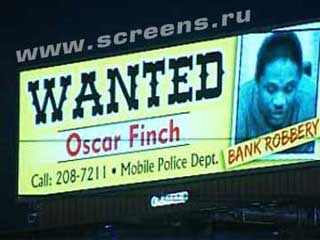 |
| Announcement on outdoor digital LED screens about wanted criminals | |
And, as a result, the number of suspects caught by the police increased too. The project spread to other cities where the digital LED signs or screens were installed. The local TV and newspapers shouted every week about new criminals apprehended by the police with help of outdoor digital LED signs. In the middle of the last year this project was discussed in the Congress and drew most favorable comments. That was another strong argument in the hands of operators in their battle against the officials.
Wanted suspects on digital LED screens wasn’t a single social project proposed by screen operators. In the beginning of 2006, Lamar Advertising agreed to broadcast for free messages of national program AMBER Alert on its own digital LED signs in Connecticut. Later other outdoor digital LED signs of Lamar joined the project.
Participation in this project was a great promotion of digital LED signs. And the fact is that the giants of outdoor industry in the USA are not going to install new media carriers based on LED technology, thus increasing the number of advertising in US streets. They just replace old static billboards with digital LED signs.
It is impossible to use static billboard in such programs as AMBER Alert. Such projects need flexibility and fast response because every second is important in case of danger. Technical specifications of digital LED screen networks (remote control, fast change of content) and sensitive attitude of American society to such social programs became a real leverage in talks with officials.
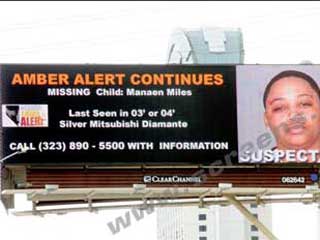 |
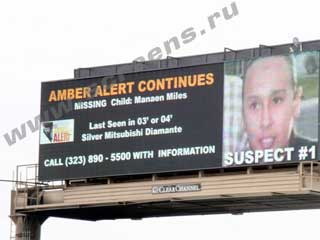 |
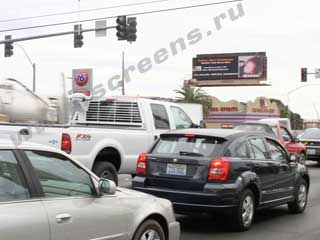 |
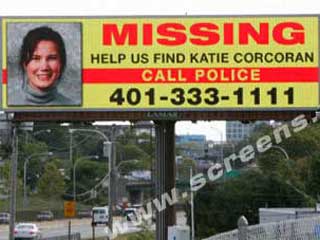 |
| Announcement on digital LED screens about missing or kidnapped children (AMBER Alert Program) | |
Studies, studies and one more studies
Very often when the compromise could not be found the studies and researches start. People are used to believe them. In case of conflict, each side embarks on an extensive research. Everybody is looking for the truth in the studies. “LED war” wasn’t an exception.
Representatives of the U.S. outdoor industry first tried to achieve it the easy way. In response to complaints that outdoor digital LED signs and screens distract drivers, blink too brightly and change messages too fast, they referred to the already existing studies about driver’s behavior on the road. Outdoor advertising was mentioned in these studies as a marginal threat to drivers, if at all. Critics said that these studies cannot be used as a proof since they were made to determine the influence of mobile phone use during driving. Finally, they said that no targeted studies were conducted to have a serious dispute on that theme.
In the beginning of 2006, a new state research about main reasons of traffic accidents was issued. Drowsiness was named the main reason. Also the list contained: use of mobile phones, eating, reading of books etc. Outdoor carriers were not on the list. The US outdoor industry used this fact to its advantage but it wasn’t enough. Their opponents insisted on the study which would show the direct relation between outdoor video screen and driver. The government has allotted $150 000 for a future study and charged the Federal Highway Administration with the responsibility.
The outdoor advertising industry decided to provide its own answer. Two studies were commissioned by the Foundation for Outdoor Advertising Research and Education. And in the middle of July, 2007 the results of the studies were released. One has examined crash causation and statistical data and another one - driver performance.
The crash causation and statistical data study was conducted by Tantala Associates. The study showed that the outdoor digital LED signs and screens had no statistically significant relationship with the occurrence of accidents. The study was made in Cuyahoga County, Ohio, near LED signs of Clear Channel. The researchers conducted both a temporal and spatial analysis of the statistics of traffic and accident data near all 7 digital LED screens in periods of 18 months before and after the screens were converted from conventional to digital. “The analysis and statistics in Cuyahoga County demonstrate that digital LED signs and screens have no statistically significant relationship with the occurrence of accidents,” said Albert M. Tantala, P.E. “Accidents are no more likely to occur near digital LED signs or screens than on highway sections without them.”
The human factor study was conducted by the Center for Automotive Safety Research at Virginia Tech’s Transportation Institute. The research concluded that “driving performance measures in the presence of digital LED signs or screens are comparable with those associated with everyday driving”. These performance measures included eye glance patterns, speed maintenance and lane keeping. “The digital billboards we studied can be considered safety-neutral in design and operations from a human factors perspective,” according to Dr. Suzanne Lee of VTTI, the project’s principle investigator. “The findings were consistent across several measures.”
Conclusion
In spite of all barriers and problems there’s no doubt that big US outdoor operators will continue to build and expand their networks of digital LED signs and screens. Of course, not all projects will be launched and maybe in some cities old static billboards will not be converted to digital LED signs. But on the whole the operators will achieve their goals because digital LED screens cannot be ignored anymore. No doubt that the number of digital LED signs will keep on increasing not only in the USA and in the world as well.
At the same time we see that outdoor digital LED sign and screen networks can serve not only like advertising carriers but also as device for authorities to inform people who are outside their homes about emergency situations. It’s also important to mention that studies proved that digital LED signs are safe for drivers and pedestrians. It also means that digital LED signs are a new constantly developing technology that will be fully embraced by modern cities in the near future.





